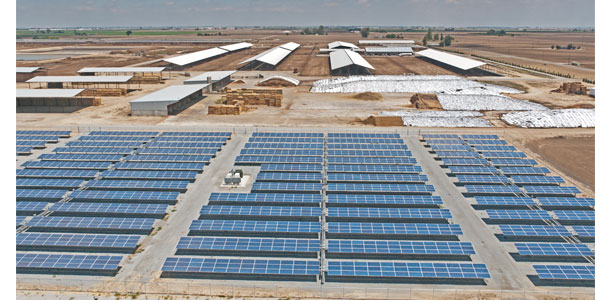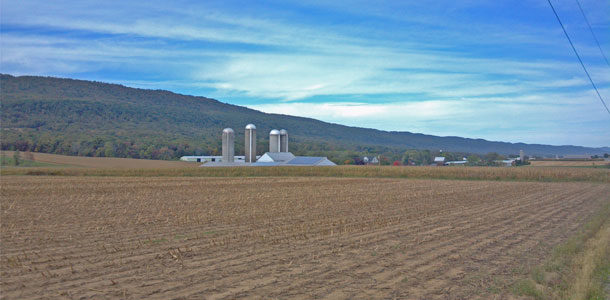Is now the time to install solar panels on your dairy farm? Are incentives still available? Solar panel prices are falling, but past solar projects have been supported by grants, tax credits or green energy subsidies.
Progressive Dairyman talked to dairy farms and their solar suppliers on opposite ends of the country about the benefits of going solar and the funding available today to make it happen.
Solar power providers say farms may be able to significantly cut energy costs, as much as 90 percent according to certain estimates, and increase profitability by going green.
That was one of the sales pitches that intrigued DD Dry Creek Farms in Martinsburg, Pennsylvania. Doug Smith and his co-owner wife, Veronica, who run the multi-generational family-owned dairy farm, report that at an agriculture show in the state, a company called Paradise Energy sparked interest with the Smiths when they saw its display of solar panel units that generate electricity. After conversing with a company representative, Doug Smith agreed to have them visit the 210-cow dairy farm and provide an estimate.
Their first estimate, a cost that covered electricity generation for 100 percent of the farm’s needs, was too high for Smith. He declined.
Eight months later, a company rep returned, informing him that grant monies were available through the USDA and the state. Additionally the company could downsize the panels to a size that made sense on his farm.
“I agreed on a 24-kilowatt system to supply one-fifth of the farm’s needs,” he says, of the unit that was installed in October 2013 for $96,000, including installation fees. “As the system is set up currently, it will offset my electric bill but won’t generate additional income, because it is a smaller size than what we use in terms of electricity,” Smith says.
He also agreed to run extra conduit to be able to add more panels and inverters if it turned out to be profitable and in anticipation of the price of panels dropping.
The USDA and PA Sunshine kicked in grant monies to sweeten the deal for Smith.
Thanks to grant money procured, tax credits (in Smith’s case, 30 percent of the installation) and potential electricity generated, Smith expects the payback on his investment within three to four years.
The return on investment, in fact, may take a bit longer, according to Matt Beiler, principal and chief financial officer of Paradise Energy.
“In Pennsylvania in particular, it may be seven to eight years until farmers see the system pay off before they would essentially get free electricity,” Beiler says. “In some cases, it might be as low as five years, but here in the Northeast/Mid-Atlantic, we definitely get less sunshine than some parts of country, like Florida or California.” Even so, he says the length of time doesn't inhibit cost effectiveness of solar.
Though Smith benefited directly from state funding, Beiler notes that there has been a decline in amount of money available through the state, though federal funding opportunities are still out there through the Rural Energy for America Program. “On top of that, when you have a farm or business, there are depreciation benefits,” Beiler says. Despite fewer incentives overall, Beiler says, “Costs have dropped so drastically so that it still makes sense to install.”
For Smith, he says, “My number one gain in this was to offset the electric bill; number two is the 30 percent tax credit.”
“Capital – or access to capital – can be the main drawback,” he says. “You are essentially paying your electric bill up front for the next 20 years; the money has to come from somewhere. There are some interesting funding opportunities that we offer that take away some burden of capital.”

On the other coast, just prior to the dairy recession, Mike Monteiro, a dairy owner and operator alongside his brother, Manuel, found himself fielding calls from U.S. investors, who saw a gold mine in his property. The Monteiro brothers then learned their 3,550-cow dairy in Hanford, California, is within a half-mile of a Pacific Gas and Electric substation. Investors were calling wanting to rent or buy their property. “They wanted to put in a large solar installation to provide electricity to this utility company,” Monteiro recalls.
“Soin 2009, I was sitting with my banker tossing around how we are going to weather the downturn in dairy,” he says. “As my banker got up to leave, I told him, ‘I've had investors calling me to put up a solar site out here. I'm considering producing my own electricity for my facility. What do you think?’”
He recommended that Monteiro start investigating options. “To me, it had to make financial sense.” Soon Monteiro made connections with SPG Solar, a solar panel supplier.
Monteiro was poised to green light the deal only if his farm could apply for and receive the California Solar Initiative incentive, and the farm could be granted a 15-cent rebate for every kilowatt-hour that his facility produced to be paid for five years after installation.
In March of 2010, he got the OK for the 15-cents-per-kilowatt funding for a large commercial solar install through SPG Solar; he was one of the first in central California to install such a system. He says that since he got approved for such funding he has learned that such funding is no longer available.
Today, his dairy farm operates with a 971-kilowatt solar system that is backed by a 10-year warranty, worth $3.5 million and covering four acres. His units pivot on an axis, tracking the sun all day long.
“If the system doesn't produce what they told me it would – they owe me money. They watch the system online daily, because they have a guarantee on this,” Monteiro says.
“Similar to an auto checkup, we perform preventive maintenance and ensure optimal performance of the system each year,” Dylan Dupre, vice president, EPC Sales, of SPG Energy, says. “If there’s a problem, the monitoring system will kick out an email and let us know if system is not producing.”
Though he generates electricity, Monteiro says it’s neither his goal nor that of the utility company for his farm to be an electricity producer. “This is designed to take care of my needs. If it produces more than I need during the day it goes back on the grid; at night when my system shuts down, I use that electricity,” he says.
So far, it looks promising. “My only responsibilities are to keep the weeds down and keep the panels washed,” he says. Every three weeks, he spends $500 to wash the panels.
He says his electricity cost would be about 16 cents in the middle of the afternoon, if he were paying out of pocket; and 5 cents at night. “When I [would be] getting charged the most I'm getting credit at the most valuable time of day. It’s a perfect fit for a dairy,” he says. A bonus, of course, is that his farm, located in California, gets plenty of sunshine.
But he says in the end, financially, sunshine or not, the numbers have to add up.
“After 18 months my banker did a financial analysis of the system and we were $250,000 dollars ahead. For me, this was cash-positive from day one, even though I expected a six- to seven-year payoff and planned on a long-term investment. It obviously turned out more positive than I thought,” Monteiro says.
For interested farms, he highly recommends seeking funding, if available. Funding options are still out there through the U.S. Department of Energy (e.g., state-based tax credits) and USDA REAP program, for examples. When Monteiro installed, there was a federal cash grant available at a rate of 30 percent of the total project cost. The federal government made a down payment to help his farm’s installation through the grant. That grant is no longer available.
“I virtually went into this project with no money out of my pocket to install and begin using it,” he says. “Today, things are different; the federal cash grant is gone – there is only a tax credit. But on the other hand, today's solar panel system costs have decreased by 30 to 35 percent,” he says.
Read a related Progressive Dairyman article aboutinvesting in solar panels. PD
Stephanie Skernivitz is a freelance writer in Berea, Ohio.
PHOTOS
TOP: The solar project at Dry Creek Farm in Martinsburg, Pennsylvania. Photo courtesy Matt Beiler.
BOTTOM: The Lakeside Dairy solar panel project. Photo courtesy Dylan Dupre.






